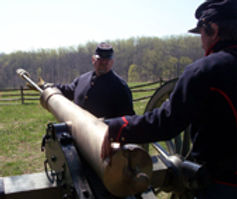top of page




WARNING!! DANGER!!
The passing in front of artillery, between cannons, or between cannons and their limbers, whether afoot or mounted is strictly prohibited when artillery is on the field. In the event that necessity deems such actions, permission shall only be granted by the battery commander or an artillery officer of higher rank.
This rule applies prior to an action, during an action and after an action.
Artillerists are instructed to take reasonable measures to insure the safety of personnel and the possibility of damage to ordnance.
--You must take care of your surroundings when near artillery.
--Always avoid commanding, riding, walking, running, dying, or redeploying in front of the guns within a 50 yard distance.
--If you are deployed between the guns allow at least 2 yards between
yourself and the gun for the cannoneer to work.
--Never march beyond the axle of the gun without direct orders from your superior officer.
--And never fire towards a Limber.





The din and smoke of the battlefield make verbal communication near impossible.
The artillery battery relies upon the use of the cannon's implements and hand signs to signal
when the cannon is loaded, when it is about to fire, when there is a misfire and when the cannon
has been rendered inoperable.
Safety is always the primary concern of everyone. The photographic illustrations below are intended to serve only as a guide for those unfamiliar with artillery procedures while on the field of battle. This is not a training web page, and it is shown only as a visual awareness for you
to be aware of artillerymen generally serving their piece.
The Artillery Reserve Assoc. Inc. would like to thank:
1st N.J. Battery A, Charlie Tarbox, 6th NY Battery, The New England Mounted Artillery Assoc.
and the 1st R.I.L.A. Battery B for their contributions to this page.


Cannoneers: Limbering and/or un-limbering the piece from the limber.
Cannoneer: Taking and/or returning implements.


Cannoneer: Worming the tube. Gun is not yet loaded.



Cannoneer: Sponging the tube.


Rammer on the muzzle signal indicates that the tube is clean and ready for the charge to be inserted and rammed.


Cannoneer: Retrieving charge from the Leather Haversack.
Cannoneer: Inserting the charge.
The gun is now considered "HOT".


Cannoneer is now ramming (seating) the charge. Gun is "HOT and LOADED".



After ramming (seating) the charge, the cannoneer places the rammer on the hub.
This signal indicates that the gun is loaded and ready to be "primed".
Cannoneers sighting the piece before "priming" (right picture).
NOTE: Rammer on the hub indicating a loaded gun.


The gun has now been "picked and primed". Cannoneers are now in a position to fire their piece.


Crossed rammers or crossed sponge and rammer (Crossed Implements)
This signal indicates "the primer has failed", and the gun is still
"HOT and LOADED" and could misfire prematurely.

Cannoneer is re-picking and priming the piece after a failed primer to refire the piece.
NOTE: Cannoneer reseats the rammer on the hub to resignal the gun is still "HOT and LOADED".


The gun has been "spiked".
This signal indicates the gun is not loaded and is safe to either pass through or to take the piece.
If this signal is not indicated, consider the piece dangerous and must be avoided.
Everyone on the field of battle must take care of their surroundings especially when near artillery.
Always try to avoid commanding, riding, walking, running, dying, or redeploying in front of the guns
within a 50 yard distance.
Always consider the guns "HOT AND LOADED"!!!
THIS IS WHY!





Tips for Infantry while Deployed near Horse Drawn Artillery

Things you need to remember...
1. They had 'right of way' in 1863 and they still do. Why? Because they have no mechanical brakes and only 2 of the horses have the ability to slow or stop the 5,000 odd pounds advancing on you.
2. Horses are trained and experienced but.... they still react to things which bother them and these are not what you might expect.
In general, horses really dislike:
High pitched noises.. caps more than loaded muskets (cap off further away) Snare drums are worse than bass, but don't fire a volley right next to them WHERE THEY CAN'T SEE IT. They don't want to be surprised. This is why the army in 1863 did not give them blinders. They have been on the field before, if they can see it they probably understand what you are doing, don't 'sneak around them'.
Claustrophobia..... 2 million years they evolved by running away from problems and not being trapped. Don't close in right next to the rigs, especially not on both sides!! Give them some space to fight over who eats which dandelion without worrying about confinement.
Flags.. They don't really understand flags.. They don't like wind anyway, it brings smells from far away so they can't rely on smell for their safety, and worse blowing in their ears it makes it harder to hear what is a threat also. So now this 'flag thing' flaps at them in the wind they already don't like and as each flag is a 'new threat' they can't be sure it isn't really trying to eat them. If the 'predator flag' 'makes a move' on a horse, the horse may try to escape the flag. Silly. So silly in fact that you ought to just hold onto the flags passing by the teams till you are well clear.
Turning space... A full six horse gun and limber is 14 yards long. Only the best exercised and trained units can turn about in less than their length.. They will be able to move up or back a little to find space, but give them some room to turn in your deployment.









bottom of page